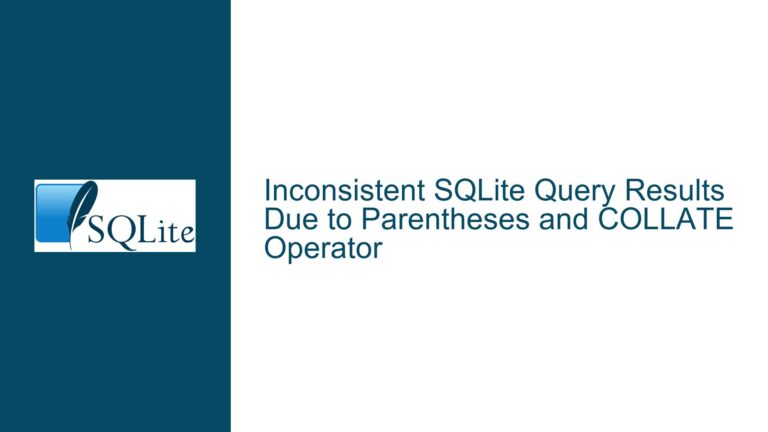Collapsing JSON Hierarchy in SQLite with Child Detection
Issue Overview: Querying JSON Tree with Child Node Detection
The core issue revolves around querying a hierarchical JSON structure stored in an SQLite database using the json_tree function. The goal is to retrieve not only the path and atom values of specific nodes but also to determine whether a given node has children. This is particularly important for building a user interface (UI) that allows users to navigate the JSON hierarchy on a "just-in-time" basis. The challenge lies in crafting a single SQL query that can efficiently return the path, atom, and a boolean flag indicating the presence of child nodes for each relevant entry in the JSON tree.
The JSON structure in question is deeply nested, with multiple levels of tags and subtags. Each tag has a title and potentially a children key, which itself contains further nested tags. The current approach uses the GLOB operator to filter nodes at specific levels of the hierarchy, but it lacks the ability to detect whether a node has children without performing additional queries. This limitation complicates the UI logic, as it requires multiple round-trips to the database to determine navigability.
The primary technical hurdle is that SQLite’s json_tree function does not natively provide a direct way to infer the existence of child nodes for a given path. While the json_tree function recursively parses the JSON structure and returns a flat table of key-value pairs, it does not inherently support aggregating or summarizing hierarchical relationships. This necessitates a creative use of SQLite’s querying capabilities to achieve the desired outcome.
Possible Causes: Limitations in JSON Tree Traversal and Aggregation
The difficulty in detecting child nodes within a JSON hierarchy stems from several inherent limitations in SQLite’s JSON support and the nature of hierarchical data structures. First, SQLite’s json_tree function is designed to flatten JSON structures into a table format, where each row represents a single key-value pair or node in the JSON tree. While this flattening is useful for querying individual nodes, it does not preserve the hierarchical relationships between nodes in a way that is easily queryable.
Second, the GLOB operator, while powerful for pattern matching, is not well-suited for detecting hierarchical relationships. It can filter nodes based on their paths, but it cannot directly infer whether a node has children. This requires additional logic to analyze the structure of the JSON tree.
Third, SQLite lacks built-in support for recursive common table expressions (CTEs) that can traverse and aggregate hierarchical data. While recursive CTEs are supported in SQLite, they are not optimized for JSON-specific operations, making it challenging to write efficient queries for deeply nested JSON structures.
Finally, the absence of a dedicated JSON aggregation function in SQLite means that developers must rely on workarounds, such as subqueries or joins, to achieve the desired functionality. These workarounds can be complex and may not perform well on large datasets.
Troubleshooting Steps, Solutions & Fixes: Crafting a Single Query for Child Detection
To address the issue of detecting child nodes in a JSON hierarchy, we can leverage SQLite’s capabilities in a more sophisticated manner. The solution involves constructing a query that not only retrieves the path and atom values but also determines whether a node has children by examining the structure of the JSON tree. Here’s a step-by-step approach to achieving this:
Step 1: Understanding the JSON Tree Structure
The JSON tree is represented as a flat table by the json_tree function, with each row containing a fullKey and an atom value. The fullKey represents the path to the node in the JSON structure, while the atom contains the value of the node if it is a leaf node (e.g., a string or number). Nodes that represent objects or arrays do not have an atom value.
Step 2: Identifying Nodes with Children
To determine whether a node has children, we need to check if there are any rows in the json_tree output where the fullKey starts with the current node’s path but extends further. For example, if the current node’s path is $.tags.tag1, we need to check if there are any rows with fullKey values like $.tags.tag1.children.*.
Step 3: Constructing the Query
We can achieve this by using a combination of LEFT JOIN and GROUP BY to aggregate the results. The query will join the json_tree table with itself, matching each node with potential child nodes. Here’s how the query can be structured:
SELECT
t1.fullKey AS path,
t1.atom AS atom,
CASE
WHEN COUNT(t2.fullKey) > 0 THEN 1
ELSE 0
END AS has_children
FROM
Tree t1
LEFT JOIN
Tree t2
ON
t2.fullKey GLOB (t1.fullKey || '.*')
AND t2.fullKey NOT GLOB (t1.fullKey || '.*.*')
WHERE
t1.fullKey GLOB '$.tags.*.title'
AND t1.fullKey NOT GLOB '$.tags.*.*.title'
GROUP BY
t1.fullKey;
Explanation of the Query:
t1andt2: These are aliases for theTreetable, allowing us to join the table with itself.LEFT JOIN: This join ensures that all rows fromt1are included, even if there are no matching rows int2.t2.fullKey GLOB (t1.fullKey || '.*'): This condition matches rows int2where thefullKeystarts with thefullKeyoft1and has one additional level of nesting.t2.fullKey NOT GLOB (t1.fullKey || '.*.*'): This condition ensures that we only match immediate children, not grandchildren or deeper descendants.CASE WHEN COUNT(t2.fullKey) > 0 THEN 1 ELSE 0 END AS has_children: This expression counts the number of matching rows int2and returns1if there are any children, otherwise0.GROUP BY t1.fullKey: This groups the results by thefullKeyoft1, ensuring that each node is represented only once in the output.
Step 4: Testing the Query
To test the query, we can run it against the provided JSON tree. The output should include the path, atom, and has_children columns, with has_children correctly indicating whether each node has children.
For example, running the query for the top-level tags:
SELECT
t1.fullKey AS path,
t1.atom AS atom,
CASE
WHEN COUNT(t2.fullKey) > 0 THEN 1
ELSE 0
END AS has_children
FROM
Tree t1
LEFT JOIN
Tree t2
ON
t2.fullKey GLOB (t1.fullKey || '.*')
AND t2.fullKey NOT GLOB (t1.fullKey || '.*.*')
WHERE
t1.fullKey GLOB '$.tags.*.title'
AND t1.fullKey NOT GLOB '$.tags.*.*.title'
GROUP BY
t1.fullKey;
Should yield:
$.tags.tag1|Tag 1|1
$.tags.tag2|Tag 2|1
This indicates that both Tag 1 and Tag 2 have children. Similarly, running the query for the children of Tag 1:
SELECT
t1.fullKey AS path,
t1.atom AS atom,
CASE
WHEN COUNT(t2.fullKey) > 0 THEN 1
ELSE 0
END AS has_children
FROM
Tree t1
LEFT JOIN
Tree t2
ON
t2.fullKey GLOB (t1.fullKey || '.*')
AND t2.fullKey NOT GLOB (t1.fullKey || '.*.*')
WHERE
t1.fullKey GLOB '$.tags.tag1.children.*.title'
AND t1.fullKey NOT GLOB '$.tags.tag1.children.*.*.title'
GROUP BY
t1.fullKey;
Should yield:
$.tags.tag1.children.tag1a|Tag 1a|1
$.tags.tag1.children.tag1b|Tag 1b|1
This indicates that both Tag 1a and Tag 1b have children.
Step 5: Optimizing the Query
While the above query works, it may not be the most efficient for large JSON trees. To optimize, consider the following:
- Indexing: Ensure that the
fullKeycolumn is indexed to speed up theGLOBoperations. - Caching: If the JSON tree does not change frequently, consider caching the results of the query to reduce database load.
- Batch Processing: If the UI allows for batch loading of nodes, modify the query to retrieve multiple levels of the hierarchy in a single query.
Step 6: Handling Edge Cases
Be aware of potential edge cases, such as:
- Empty Children Arrays: Nodes with an empty
childrenarray should still be marked as having children if the array exists. - Malformed JSON: Ensure that the JSON structure is well-formed to avoid unexpected behavior in the query.
By following these steps, you can effectively query a JSON hierarchy in SQLite, retrieving not only the path and atom values but also determining whether each node has children. This approach enables the UI to dynamically load and display the JSON tree, providing a seamless user experience.






